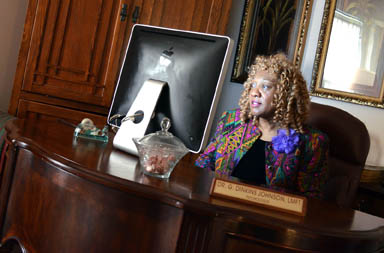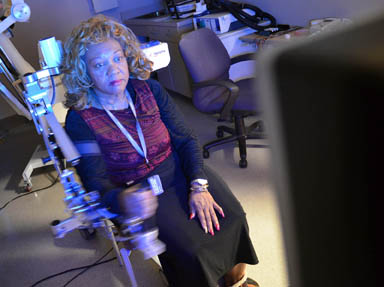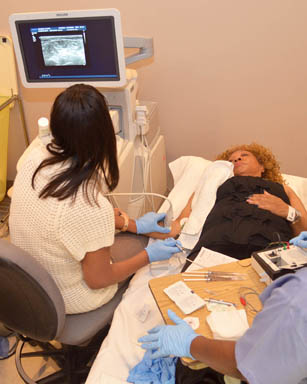As a grief counselor, Dr. Gladys Johnson has dedicated her life to helping people in times of crisis.
But on March 17, she found herself in a crisis of her own.
“I felt very weak on my right side, my hand didn’t work very well and I couldn’t walk well,” she said. “So I drove myself to the hospital and waited in the emergency room for 45 minutes.
“I should have just called an ambulance,” she adds with a laugh. “But at that point, I didn’t know if it was a stroke or what.”
It was a stroke, one that greatly impaired movement on her right side. But the Ridgeland resident never considered giving up her calling. “It happened on a Saturday and I had work to do on Monday!” she said. “That was what I wanted to get back to because my work is my life.”
Johnson heads Jackson’s Wellington Institute, where she serves as a psychologist, psychotherapist, grief counselor, marriage and family therapist, educator and researcher. One of her areas of expertise is providing grief counseling for children coping with death.
To achieve her goal of returning to work, Johnson turned to Methodist Rehabilitation Center. She spent two weeks in the Jackson hospital’s inpatient stroke program, the first step toward a recovery that is still ongoing.
“We tell all our stroke patients that you will make some improvement here, but you’re never going to leave here perfect,” said Dr. Alyson Jones, who leads Methodist Rehab’s stroke recovery program. “Some strokes take 3 to 6 months to see where you’re going to be and some take up to 18 months. So a lot of work keeps going into recovery.
“This is the kick start here,” she said. “Most of the work comes after you go home.”
Johnson made the most significant gains during physical and occupational therapy sessions at Methodist Outpatient Rehabilitation in Flowood.
“It’s wonderful what they’ve done for me,” Johnson said. “I went there in a wheelchair that I could not get out of without assistance. I had no movement of my right arm and hand. They worked diligently with me and encouraged me and made me feel like I would get better.”
“By the time she left, she was walking without an assistive device at home, but with a cane out in the community,” said Lisa Indest, Johnson’s physical therapist.
Now, her walking is aided by an electrical stimulation device recommended by Indest. Worn on the lower leg, the Bioness L300 helps Johnson overcome foot drop by electrically stimulating the nerves and muscles that lift the forefoot.
Reclaiming movement in her right arm has been more challenging due to abnormal muscle tone. But with occupational therapist Suzanne Colbert’s help, Johnson learned to rely on her left hand to operate her computer.
“She loved her patients and wanted to get back to work, so she was very adaptive and resourceful,” Colbert said. “She basically became left-hand dominant.”
“I’m having to do some things a little differently, but I can still do them,” said Johnson, who returned to work in July. “I can see patients, I can teach my classes.”
Nearly a year after her stroke, Johnson continues to improve with the help of some innovative therapies.
Dr. Jones has been addressing the muscle tightness in Johnson’s right arm with injections of paralyzing botulinum toxin. It’s akin to cosmetic Botox therapy, only wrinkle reduction isn’t the goal.
“Basically, we use it to decrease spasticity,” Dr. Jones said. “When muscles aren’t able to lengthen out any more, they can get contracted. This can cause joint deformities and lead to increased pain.”
Johnson also has benefitted from Methodist Rehab’s Armeo®Spring system, which consists of a robotic exoskeleton coupled with a virtual reality training program. The exoskeleton off-loads arm weight on her weakened right side, allowing Johnson to perform game-like exercises that address various therapy goals.
“Now I have more range of motion in my arm and movement in my fingers,” she said. “Hopefully, continuing with the Botox and Armeo, we will see some very good results.”
As she has progressed, Johnson has used her experience to inspire others. “She helped host one of our stroke support groups, speaking from a stroke survivor’s standpoint, and it was wonderful,” Indest said.
“In therapy, she was kind of a rare person, I think because of her experience with grief counseling,” Colbert said. “She was like, ‘OK, this is what I’ve been dealt, and I’ve got to move on. I can’t just sit here.’ She was an inspiration to others.”
So while Johnson wasn’t quite able to get to that pressing work she had to do the Monday after her stroke, she is grateful that Methodist Rehab has gotten her back to the office for good.
“At first I thought they were kidding when they said you’re going to walk, get out of this wheelchair, and use your right hand, but they were not,” Johnson said. “They just continued using different techniques that have helped me to get stronger and stronger."



